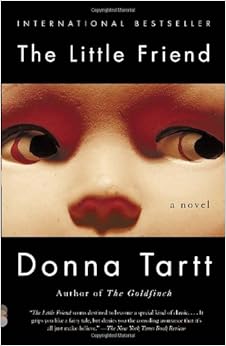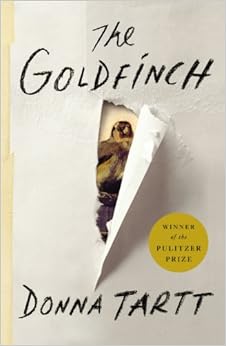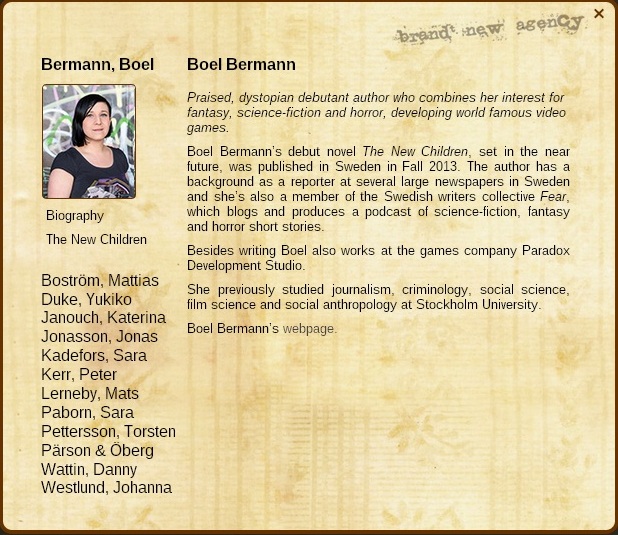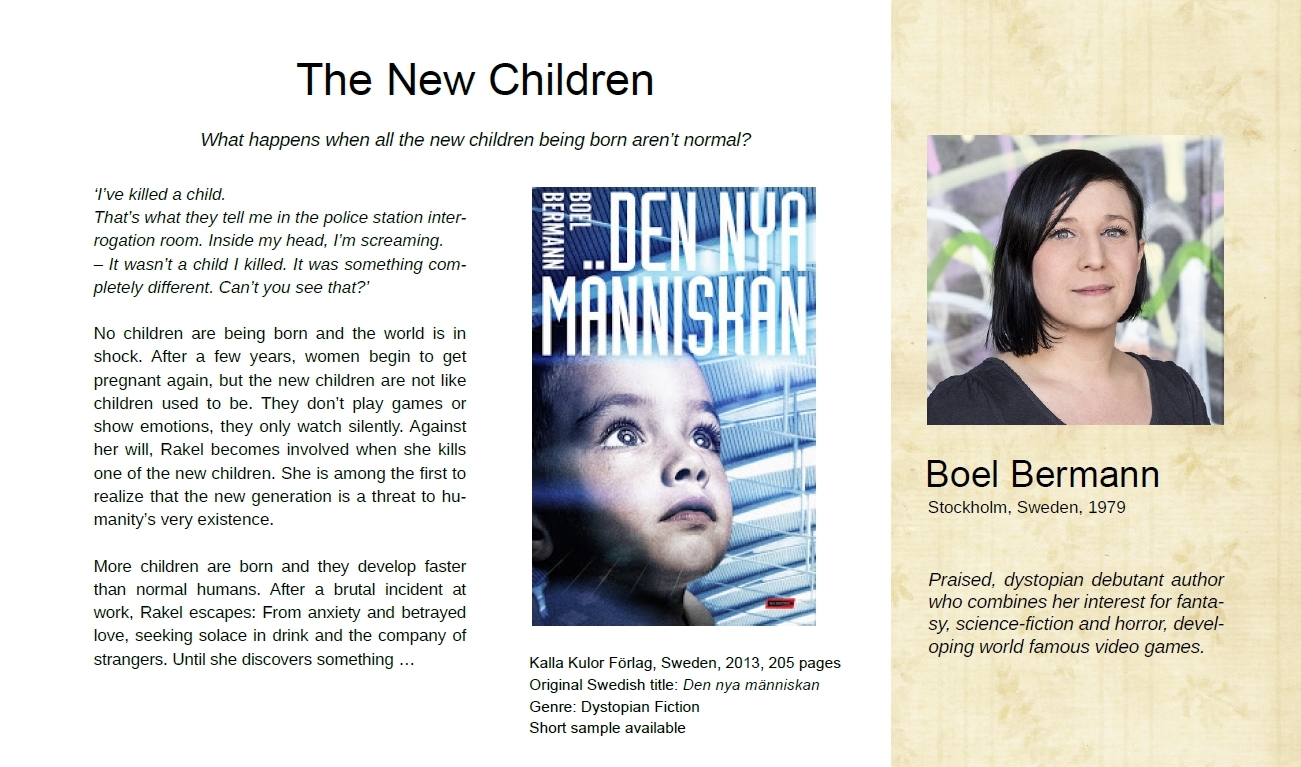
Boel Bermann (1979) is a born storyteller. She used to work as a reporter for several large newspapers and is a member of the Swedish collective, Fear. Besides writing world-famous video games, she has also written her debut novel, The New Children: a fast-paced, gripping and heartbreaking dystopian tale, published by Swedish publisher Kalla Kulor Förlag in 2013. The New Children received rave reviews and appeals to readers of all ages. We are delighted to introduce this all-round debutant. We talked with her about what dystopian novels can teach us and how to make the unbelievable believable.
BNA: You are working in the games industry. What do you exactly do?
I work for the Paradox Development Studio games company and I have the amazing job of being a game writer for a role-playing game based on Norse mythology. I create characters, quests and events and try to challenge the player with the adventures they face and provide them with enough choices to create their own story.
The strangest part is that being a game writer and being an author is completely separate in my mind. I go to work and delve deep into Norse mythology and write fantasy in English about gods, trolls and rune stones. Then I come home and keep writing – but then I write science fiction in Swedish and explore the future. I think I separate the two by writing in different languages and different genres, so one is my work and the other is my creative hobby.
BNA: How does that experience help you with your writing?
It makes me think out of the box. When writing a novel, you choose what your characters do. But in a game, the person playing your game is deciding and you need to be prepared for the gamer to choose anything. I think it helps me to think of all the possible ways in which my stories could go and not just stay attached to one path.
BNA: We are told you love horror and sci-fi. Where does that fascination come from?
From reading the news, actually. Every time I read the news, I feel the urge to change the world and the future. Sometimes it´s really hard to relate to news that is very close to your reality, so I actually think it´s easier to relate to the things we face every day if we place them in a fictional setting in the future. I love thinking about the future, about things that may come and threats and trends we can prevent.
BNA: The New Children is your debut. Could you briefly explain what the novel is about?
In the novel, no children are being born and the world is in shock. After a few years, women begin to get pregnant again, but the new children are not like children used to be. They don’t play games or show emotions, they only watch silently. Against her will, the main character, Rakel, becomes involved when she accidentally kills one of the new children. She is among the first to realize that the new generation is a threat to humanity’s very existence.
BNA: Why did you choose to write this story?
I wanted to make people think about how they would react to the fact that humanity is dying. About what we humans are prepared to do for our own survival. I don´t believe humanity is evil, but I´m convinced that, to preserve what we have, we would go far beyond what we believe ourselves capable of. To protect the persons we love and to avoid seeing things that hurt.
BNA: The book is also about a new generation that develops faster than ‘normal’ people. How did you come up with such a brilliant but terrifying idea?
I wanted humanity to be certain that they are the last generation of their kind. But with the new children growing up, they would still be distant, they would always be younger than us. So I decided that if they developed faster, they would be a more real threat because they might even take over before humanity has died out.
BNA: The main text is interspersed with news articles and interviews. Why did you use this structure?
My main character Rakel is quite introvert and views the world with a distant gaze. So I wanted the novel to give something more than her point of view, due to the fact that she is so focused on her own life. I wanted a larger perspective, but I only wanted one main story – the one Rakel lives through. Therefore, in parallel to the story, I decided to use fictional in-depth interviews from research articles to get short freeze frames of different people’s views of the world.
The newspaper articles were a result of my own frustration with how much I fail to grasp of what is going on in the world. Even though I follow the news every day, I still feel that I only get bits and pieces that rarely come together to create a bigger picture. What I hope is that the articles add to the sense of realism of the story and make it more believable as well as giving a brief overview of how someone would perceive everything that is happening.
BNA: The story is a real page turner. How did you manage to keep up the pace?
I never wanted the reader to feel safe or relaxed. I usually cut the scenes down and left them unfinished, because I wanted the reader to create them in their own minds. Strangely enough, I didn’t think of the novel as a page-turner when I wrote it, probably because I actually knew most of what would happen. But I realized that it’s nearly impossible to put down once you start reading, which of course is marvelous.
BNA: The main character Rakel is an anti-hero who lives a dissolute life: she sleeps with different men, is often hung over and, on top of that, she kills a child. Why did you choose her as the main character?
I wanted the main character to feel like a real person, and I don´t really believe that there are people that are all good. Even good people can do bad things and have destructive personality features. But I have to admit that I also love to write in the first person when the main character is hard to identify with, because then I´m actually forcing you as a reader to see the world from her point of view.
Of course Rakel is a very broken person. I wanted her to evolve so, in the first part of the novel, she is quite passive. She doesn’t care about the end of mankind, she mostly cares about her everyday life. Then, without giving any of the story away, she changes in the latter part – finding something that actually makes her act rather than react. But she did drive me insane sometimes: I’d sit there and curse at the computer. Oh come on, do something and stop looking at the world as if it were pitch black all the time. Rakel and I are very different people, and I doubt we’d be friends if she were real.
BNA: Was it difficult to write about the future?
The future portrayed in The New Children is extremely close in time and occurs in a society that largely resembles our own. I wanted to explore how the human race would react when ordinary people realize that they are probably the last generation of their kind. What is the private, political and social? One reviewer wrote something that meant the world to me: “I think that the dystopian lies as much in the present as in the future as depicted, for the unacceptable is already happening, and the monsters already exist.’’
BNA: We know that dystopian novels are one of your favorite genres. Why is that?
I’ve always loved dystopias because they are in between everyday life and the end of the world as we know it. You still have a society where people try to live their everyday life, but the structure of society is withering away. The strength of dystopias is that they make the reader ask: What would I do? Would I strive to change anything or just look the other way? Since I stay so close to today’s reality, I didn´t have to invent a completely new world, I only had to twist and bend the world we live in and then see what would happen…
BNA: How did the writing process go? Did you face any difficulties?
With a full time job and a social life, the writing did take time. I mostly wrote during vacations, evenings and in meetings of my writing collective, Fear. I didn’t have many problems writing the novel; it came very naturally. My real challenge was in the later part when I had to edit it. I’m critical, so I just kept cutting out pieces I felt were dead meat. That probably helped the novel’s pacing as well – since I removed a lot of the breathing space for the reader.
BNA: Which books or writers inspired you?
It seems that dystopias usually surface when the world is going through a crisis and right now we are in the middle of a wave of dystopias in literature. I personally adore Margaret Atwood’s novels, especially her Maddaddam trilogy, and I feel that her strength lies in how she explores current social trends and pushes them right to the edge of what we can believe.
BNA: The New Children is beautiful but also heartbreaking. Didn’t you find it hard to write such an incredibly sad story?
I needed to believe in my main character Rakel, to believe she was real. Because if I didn’t believe in her, then nobody else would. I felt that if I could make the reader believe in Rakel, they would believe anything I told them in The New Children – even that the children being born were different. I wanted to make the unbelievable believable.
Interview first published at Brandt New Agency.
Represented by Brandt New Agency
Watch the New Children Book Trailer here:
https://www.youtube.com/watch?v=ujzDBv5Eaf8






Kommentarer